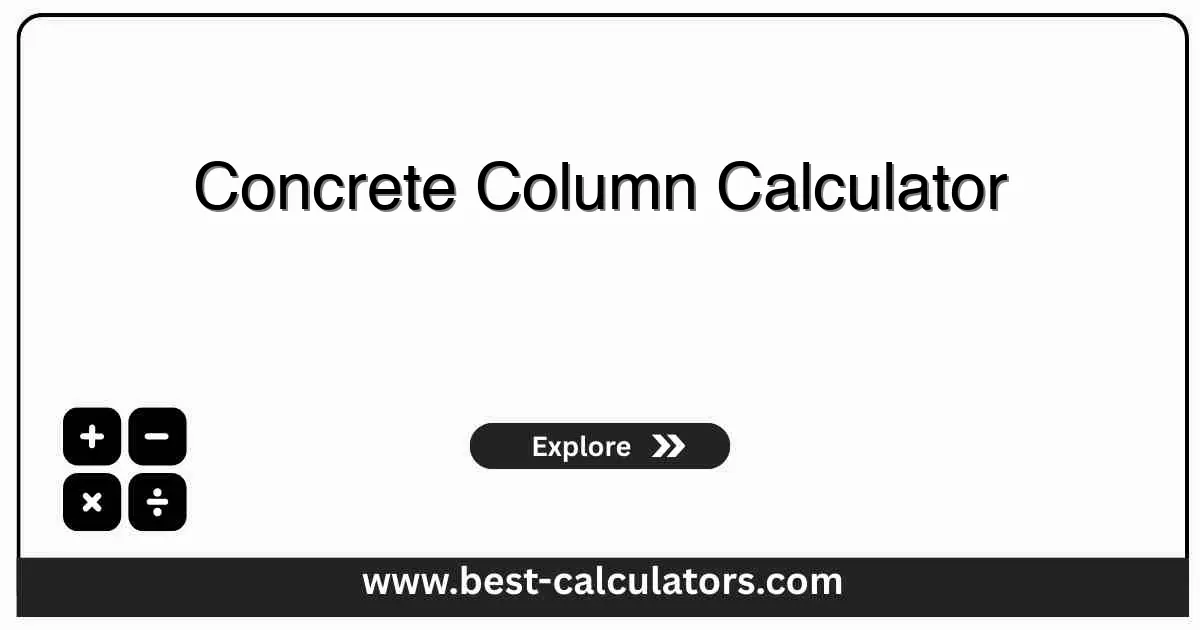Concrete Column Calculator - Calculate Column Concrete Volume
Estimate concrete volume and bag requirements for circular and rectangular columns with waste allowance using precise, construction-grade formulas.
Concrete Column Calculator
Results
All results are rounded up to ensure sufficient concrete. Always confirm with supplier mix data and local building codes.
What is a Concrete Column Calculator?
A Concrete Column Calculator is a specialized construction tool that estimates the concrete volume and bag quantities required for reinforced concrete columns. It supports both circular and rectangular columns so you can size pours for decks, footings, porches, interior supports, and structural frames with confidence.
This calculator works for:
- Deck and porch posts – Sonotube-style round columns and square pedestal columns.
- Structural building columns – Regular grids of RC columns in residential and light commercial projects.
- Footing and pier replacements – Estimating column concrete when upgrading or repairing supports.
- Fence and gate posts – Oversized column-style footings and feature columns.
To estimate concrete for larger slabs, driveways, or footings connected to your columns, use our Concrete Calculator to calculate total volume across all structural elements.
For driveway or apron areas supported by your columns, check our Concrete Driveway Cost Calculator to estimate complete project cost including materials and labor.
To properly size foundations and footings under your columns, explore our Deck Footing Calculator to determine the number and spacing of supports.
For reinforcement planning around your concrete columns, use our Rebar Calculator to estimate steel quantities based on column size and layout.
To convert overall project volumes into transport weights and bulk orders, try our Tonnage Calculator to align with supplier logistics and delivery constraints.
How the Concrete Column Calculator Works
The calculator uses standard geometric formulas to compute volumes in cubic feet, converts them to cubic yards, and applies your selected waste factor.
Bag counts are then calculated using typical yields per bag and rounded up to ensure you never run short on site.
- D = column diameter in inches.
- W = rectangular column width in inches.
- T = rectangular column depth/thickness in inches.
- H = column height in feet.
- N = number of identical columns.
Key Concepts for Concrete Columns
Effective Volume
Volume is derived from clear dimensions inside the formwork. Small changes in diameter or cross-section significantly change total volume for multi-column layouts.
Bag Yields
Pre-mix bag yields are based on manufacturer data. This calculator uses industry-standard approximate values and rounds up to full bags.
Waste Factor
Accounts for over-excavation, spillage, edge rounding, and consolidation. Essential for column pours where access is tight.
Uniform Columns
The tool assumes all columns use the same dimensions. For mixed sizes, run separate calculations and sum totals.
How to Use This Concrete Column Calculator
Select Column Shape
Choose circular for round forms (sonotubes) or rectangular for square/rectangular RC columns.
Enter Dimensions
Input diameter or width/depth in inches and height in feet using actual formwork sizes.
Set Column Count
Enter how many identical columns you will pour at the same size.
Adjust Waste
Add 10–15% waste for realistic on-site usage and uneven excavations.
Choose Bag Size
Select preferred bag size or view all 40, 60, and 80 lb bag counts for purchasing options.
Review Results
Check volume per column, total volume, and bag quantities rounded up for safe ordering.
Benefits of Using This Concrete Column Calculator
- • Fast, accurate estimates: Avoid manual geometry mistakes when sizing multiple columns.
- • Optimized purchasing: See bag counts by size to match local supplier packaging.
- • Reduced waste: Waste factor integration helps order slightly more than needed without overspending.
- • Professional planning: Ideal for builders, estimators, and serious DIYers preparing detailed material lists.
- • Consistent methodology: Uses standard, transparent formulas that align with industry practice.
Factors That Affect Your Column Concrete Requirements
1. Actual Form Dimensions
Using nominal sizes instead of true internal dimensions can under or over estimate volume. Always measure the actual form or excavation.
2. Column Height Variations
Sloping slabs or grade beams can cause height differences between columns. When heights vary, calculate groups separately.
3. Mix Yield Differences
Different bag mixes and aggregate gradations have slightly different yields. Always confirm yields with manufacturer data when ordering.
4. Consolidation and Voids
Poor vibration can leave voids; over-vibration can cause segregation. Both influence the practical concrete needed on site.
5. Code & Engineering Requirements
Structural safety, cover to reinforcement, and minimum sizes are governed by design codes. Use this tool for volume estimation, not for structural adequacy checks.

Frequently Asked Questions (FAQ)
Q: How do I calculate concrete volume for a round column?
A: Use V = π × (D/12/2)² × H. D is diameter in inches, H is height in feet. Multiply by the number of columns, then divide by 27 to convert to cubic yards.
Q: How do I calculate concrete volume for a rectangular column?
A: Use V = (W/12) × (T/12) × H. W and T are width and depth in inches, H is height in feet. Multiply by the number of columns and divide by 27 for cubic yards.
Q: How much extra concrete should I include for column pours?
A: Typically, include 10–15% extra to cover waste, spillage, minor excavation changes, and consolidation losses.
Q: How many 40 lb, 60 lb, or 80 lb bags equal one cubic yard?
A: Approximate values: 40 lb ≈ 0.30 ft³ (about 100 bags/yd³), 60 lb ≈ 0.45 ft³ (about 67 bags/yd³), 80 lb ≈ 0.60 ft³ (about 45 bags/yd³).
Q: Is this calculator enough for structural design?
A: No. It only estimates concrete quantity. Structural design, reinforcement, and safety checks must be done by a qualified engineer according to local codes.
Q: Can I use different dimensions for each column?
A: This version assumes identical columns. For mixed sizes, run separate calculations for each group and add the results together.